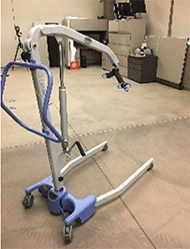J. Hoydick1,2, M. Greenhalgh, B.S1,3, R. Cooper, PhD1
1Human Engineering Research Laboratories, Veterans Affairs Pittsburgh Health Care System, University Drive, Pittsburgh, PA,
2Department of Biomedical Engineering, Duquesne University, Pittsburgh, PA,
3 Department of Epidemiology, Graduate School of Public Health, University of Pittsburgh, Pittsburgh, PA
INTRODUCTION

Caregivers are essential resources in healthcare, as over 39 million adults in the United States provide care to a person who is disabled, ill, or elderly. [1] Informal caregivers, which include family and friends, provide approximately 87% of long-term care. [2] Formal caregivers, including home health aides, nursing aides and personal care aides, are expected to increase by 47% from 2010 to 2020. [3] Caregivers perform a variety of tasks, some of which are physically demanding, such as transferring patients to and from wheelchairs. [4]

Mechanical lifting devices such as the Hoyer lift are an improvement compared to manual lifting, yet still have limited use in crowded spaces and leaves a risk for shoulder and back injuries. [5] In contrast, the StrongArm RATD has a more compact design, making it more suitable for tight spaces, and uses an electronically controlled joystick to perform the transfer. A recent cross-sectional study showed that caregivers favored StrongArm over the Hoyer lift for both task load demand and transfer usability. [6]
As informal caregivers are more prevalent than formal caregivers, it is important to determine which type of device is more suitable in a home setting. [7] This study aims to determine whether there is a significant difference in muscle activation between formal and informal caregivers when using assisted transfer devices, including the Hoyer lift and StrongArm, and to compare usability, demand, and muscle activation between both devices. It is hypothesized that formal caregivers, or those with more formal experience, encounter less muscle activation using assisted devices for transfers than informal caregivers. Additionally, it is hypothesized that both groups experience reduced muscle activation and task demand using the StrongArm compared to the Hoyer at three distinct surfaces and phases to and from a wheelchair.
REFERENCES
- Yuen, E. Y., Knight, T., Ricciardelli, L. A. and Burney, S. (2018), Health literacy of caregivers of adult care recipients: A systematic scoping review. Health Soc Care Community, 26: e191-e206. doi:10.1111/hsc.12368
- The Scan Foundation (2012) http://www.thescanfoundation.org/sites/thescanfoundation.org/files/us_who_provides_ltc_us_oct_2012_fs.pdf
- Jeannis, H., Grindle, G. G., Kelleher, A., Wang, H., Brewer, B., & Cooper, R. (2013). Initial development of direct interaction for a transfer robotic Arm system for caregivers. 2013 IEEE 13th International Conference on Rehabilitation Robotics (ICORR). doi:10.1109/icorr.2013.6650390
- Garg, B. Owen, D. Beller & J. Banaag (1991) A biomechanical and ergonomic evaluation of patient transferring tasks: wheelchair to shower chair and shower chair to wheelchair, Ergonomics, 34:4, 407-419, DOI: 10.1080/00140139108967325
- Burkman, J., Grindle, G., Wang, H., Kelleher, A., & Cooper, R. A. (2017). Further Development of a Robotic- Assisted Transfer Device. Topics in Spinal Cord Injury Rehabilitation, 23(2), 140-146. doi:10.1310/sci2302-140
- Greenhalgh, M., Landis, J. M., Brown, J., Kulich, H., Bass, S., Alqahtani, S., . . . Cooper, R. A. (2019).Assessment of Usability and Task Load Demand Using a Robot-Assisted Transfer Device Compared With a Hoyer Advance for Dependent Wheelchair Transfers. American Journal of Physical Medicine & Rehabilitation, 98(8), 729-734. doi:10.1097/phm.0000000000001176
- Solé-Auró, A., & Crimmins, E. M. (2012). Who cares? A comparison of informal and formal care provision in Spain, England and the USA. Ageing and Society, 34(3), 495-517. doi:10.1017/s0144686x12001134
- Fairbank JC, Pynsent PB: The Oswestry Disability Index. Spine 2000;25:2940–53
- Winwood PC, Winefield AH, Dawson D, et al: Development and validation of a scale tomeasure work-related fatigue and recovery: the Occupational Fatigue Exhaustion/RecoveryScale (OFER). J Occup Environ Med 2005;47:594–606
- ADA Standards for Accessible Design (2010) https://www.ada.gov/2010ADAstandards_index.htm, accessed June 11, 2019.
- Hart SG. NASA-task load index (NASA-TLX); 20 years later. In Proceedings of the Human Factors and Ergonomics Society Annual Meeting. 2006;50(9):904-908.
ACKNOWLEDGEMENT
This work was funded by ASPIRE (Grant #:1560174), the VA Merit Review (Grant #: F1454R), VA Center for Excellence for Wheelchairs and Associates Rehabilitation (Grant #: B9250-C), Integrative Graduate Education and Research Traineeship (Grant #: DGE1144584), and Paralyzed Veterans of America. The contents of this paper do not represent the views of the U.S Department of Veterans Affairs or the United States Government. The author reported no conflicts of interest.